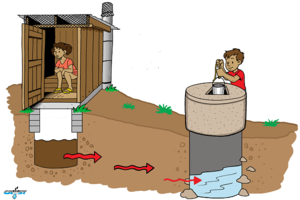**Waterborne Diseases Overview:**
– Definition: Waterborne diseases are transmitted through polluted water via ingestion or contact.
– Causes: Lack of clean water supply, sanitation, and hygiene are major factors.
– Transmission: Mainly occurs through the fecal-oral route.
– Prevention: Reliable access to clean drinking water and sanitation is crucial.
**Types of Waterborne Diseases by Pathogen:**
– Protozoa: Acanthamoeba keratitis, Amoebiasis, Cryptosporidiosis, Cyclosporiasis, Giardiasis.
– Bacteria: Campylobacteriosis, Cholera, E. coli infection, M. marinum infection, Dysentery, Legionellosis, Leptospirosis, Otitis Externa, Salmonellosis, Typhoid fever.
– Viral: Hepatitis A, BK virus, JC virus.
– Algae-Related: Desmodesmus infection.
– Parasitic Worms: Dracunculiasis (Guinea worm disease).
**Impact and Epidemiology of Waterborne Diseases:**
– Global Burden: 1.5 million deaths annually, accounting for 3.6% of the global burden of disease.
– Socioeconomic Impact: Families spend about 10% of monthly income per infected person.
– United States: Surveillance by WBDOSS since 1971, supporting EPA regulations and CDC activities.
**Prevention and Management of Waterborne Diseases:**
– Prevention Methods: Aim to break the fecal-oral route of transmission.
– Economic Impact: Waterborne diseases can significantly impact the economy.
– History: Waterborne diseases historically linked to water quality and miasma theory.
**Additional Information and Resources:**
– Climate Change: Impacts transmission of infectious diseases, including waterborne diseases.
– Surveillance and Early Detection: Essential for monitoring and prevention.
– Treatment Methods: Boiling water, chlorination, filtration, UV radiation, and water treatment.
– Global Impact: 2.2 billion lack safely managed drinking water, 4.2 billion lack sanitation services.
Waterborne diseases are conditions (meaning adverse effects on human health, such as death, disability, illness or disorders) caused by pathogenic micro-organisms that are transmitted by water. These diseases can be spread while bathing, washing, drinking water, or by eating food exposed to contaminated water. They are a pressing issue in rural areas amongst developing countries all over the world. While diarrhea and vomiting are the most commonly reported symptoms of waterborne illness, other symptoms can include skin, ear, respiratory, or eye problems. Lack of clean water supply, sanitation and hygiene (WASH) are major causes for the spread of waterborne diseases in a community. Therefore, reliable access to clean drinking water and sanitation is the main method to prevent waterborne diseases.
| Waterborne diseases | |
|---|---|
 | |
| Waterborne diseases can be spread via groundwater which is contaminated with fecal pathogens from pit latrines. | |
| Specialty | Infectious disease |
Microorganisms causing diseases that characteristically are waterborne prominently include protozoa and bacteria, many of which are intestinal parasites, or invade the tissues or circulatory system through walls of the digestive tract. Various other waterborne diseases are caused by viruses.
Yet other important classes of waterborne diseases are caused by metazoan parasites. Typical examples include certain Nematoda, that is to say "roundworms". As an example of waterborne Nematode infections, one important waterborne nematode disease is Dracunculiasis. It is acquired by swallowing water in which certain copepoda occur that act as vectors for the Nematoda. Anyone swallowing a copepod that happens to be infected with Nematode larvae in the genus Dracunculus, becomes liable to infection. The larvae cause guinea worm disease.
Another class of waterborne metazoan pathogens are certain members of the Schistosomatidae, a family of blood flukes. They usually infect people that make skin contact with the water. Blood flukes are pathogens that cause Schistosomiasis of various forms, more or less seriously affecting hundreds of millions of people worldwide.
